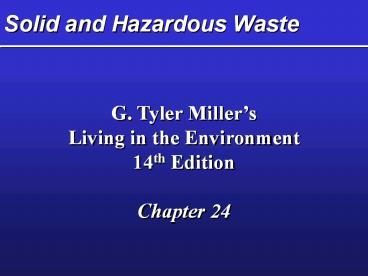Solid and Hazardous Waste - PowerPoint PPT Presentation
Title:
Solid and Hazardous Waste
Description:
Solid and Hazardous Waste G. Tyler Miller s Living in the Environment 14th Edition Chapter 24 Key Concepts Types and amounts of wastes Methods to reduce waste ... – PowerPoint PPT presentation
Number of Views:250
Avg rating:3.0/5.0
Title: Solid and Hazardous Waste
1
Solid and Hazardous Waste
G. Tyler Millers Living in the Environment 14th
Edition Chapter 24
2
Key Concepts
- Types and amounts of wastes
- Methods to reduce waste
- Methods of dealing with wastes
- Hazardous waste regulation in the US
3
Wasting Resources
- Industrial and agricultural waste
- Municipal solid waste
Fig. 24-2 p. 533
- US 11 billion metric tons/year
4
Producing Less Waste and Pollution
- Waste management (high waste approach)
- Burying, burning, shipping
- Waste prevention (low waste approach)
- Reduce, reuse, recycle
- Sustainability Six
5
Dealing with Material Use and Wastes
Fig. 24-3 p. 535
6
Solutions Cleaner Production
- Ecoindustrial revolution
- Resource exchange webs
- Biomimicry
- Service-flow economy
7
Solutions Selling Services Instead of Things
- Service-flow economy
- Uses a minimum amount of material
- Products last longer
- Products are easier to maintain, repair, and
recycle
- Eco-leasing
See Individuals Matter p. 538
8
Reuse
- Extends resource supplies
- Saves energy and money
- Reduces pollution
- Create jobs
- Reusable products
9
Recycling
- Primary (closed-loop)
- Secondary (open loop)
- Preconsumer waste
- Postconsumer waste
Fig. 24-6 p. 539
10
Characteristics of Recyclable Materials
- Easily isolated from other waste
- Available in large quantities
- Valuable
11
Benefits of Recycling
Fig. 24-8 p. 541
12
Recycling Methods
- Centralized recycling of mixed waste
(Materials-Recovery Facilities, MRFs)
- Source separation
- Pay-as-you-throw (PAUT)
13
Case Studies Wastepaper and Plastics
- 49 of wastepaper recycled in US
- Chlorine-based compound in paper production
- 10 or less of plastic recycled in US
- Plastics can be very difficult to recycle
14
Burning Wastes
- Mass burn
- incineration
- Air pollution
- Waste to energy
Fig. 24-13 p. 546
15
Burying Wastes
- Open dumps
- Sanitary landfills
- Leachate collection
- Monitoring wells
- Emit greenhouse gases (CO2 and methane)
16
Sanitary Landfill
Fig. 24-14 p. 547
17
Sanitary Landfills Trade-offs
Fig. 24-15 p. 548
18
Hazardous Wastes Types
- Contains at least one toxic compound
- Catches fire easily
- Reactive or explosive
- Corrodes metal containers
19
Not Hazardous Wastes under RCRA
- Radioactive wastes
- Household wastes
- Mining wastes
- Oil and gas drilling wastes
- Liquids containing organic hydrocarbons
- Cement kiln dust
- lt100 kg (220 lb) per month
20
Dealing with Hazardous Wastes
Fig. 24-17 p. 550
21
Detoxifying and Removing Wastes
- Physical methods
- Chemical methods
- Bioremediation
- Phytoremediation
- Plasma incineration
22
Deep-well Disposal
Fig. 24-21 p. 553
23
Hazardous Waste Landfill
Fig. 24-23 p. 554
24
Surface Impoundments Trade-offs
Fig. 24-22 p. 553
25
Case Studies Lead
- Lead poisoning major problem in children
Primary Sources of Lead
- Leaded gasoline (phased out by 1986)
- Lead paint (banned in 1970)
- Lead in plumbing
- Progress is being made in reducing lead
26
Case Studies Mercury
- Vaporized elemental Mercury
- Fish contaminated with methylmercury
- Natural inputs
- Emission control
- Prevention of contamination
27
Case Studies Dioxins
- Potentially highly toxic chlorinated hydrocarbons
Sources of Dioxins
- Waste incineration
- Fireplaces
- Coal-fired power plants
- Paper production
- Sewage sludge
28
Hazardous Waste Regulation in the United States
- Resource Conservation and Recovery Act
- (RCRA)
- Comprehensive Environmental Response,
Compensation, and Liability Act (Superfund)
- National Priority List
- Polluter-pays principle
29
Solutions Achieving a Low-Waste Society
- Local grassroots action
- International ban on 12 persistent organic
pollutants (the dirty dozen)
- Precautionary Principle































